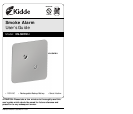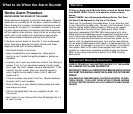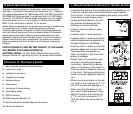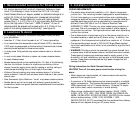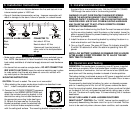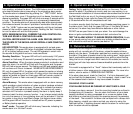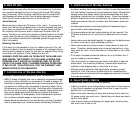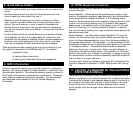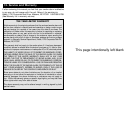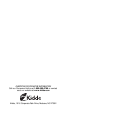
4. Operation and Testing
from cooking, activates the alarm. The HUSH feature cannot be activat-
ed unless the smoke alarm is sounding in the originating alarm mode.
The smoke alarm is desensitized by pushing the “ TEST / HUSH” button
on the smoke alarm cover. If the smoke is not too dense, the alarm will
silence immediately. The green LED will blink once every 3 seconds while
in hush. This indicates that the alarm is in a temporarily desensitized
condition. The smoke alarm will automatically reset after approximately
8 minutes and sound the alarm if particles of combustion are still pres-
ent. The “HUSH” feature can be used repeatedly until the air has been
cleared of the condition causing the alarm. Pushing the Test / Hush but-
ton on the alarm will end the hush period.
NOTE: DENSE SMOKE WILL OVERRIDE THE HUSH CONTROL FEA-
TURE AND SOUND A CONTINUOUS ALARM.
CAUTION: BEFORE USING THE ALARM HUSH FEATURE, IDENTIFY
THE SOURCE OF THE SMOKE AND BE CERTAIN A SAFE CONDITION
EXISTS.
LED INDICATORS:
This smoke alarm is equipped with red and green
LED indicators. The green LED (when illuminated) indicates the presence
of AC or battery backup power. The red LED operates in unison with
the sounder during alarm and error mode conditions:
Standby Condition: The green LED will be lit continuously if AC power
is present or flash every 30 seconds if powered by battery backup only.
Alarm Condition: When the alarm senses products of combustion and
goes into alarm, the red LED will flash with the sounder and the green
LED will flash once per second. The flashing red LED and pulsating alarm
will continue until the air is cleared. WHEN UNITS ARE INTERCONNECT-
ED, only the green LED of the alarm which senses the smoke or is being
tested (the originating unit) will flash. All other units in the interconnect
system will sound an alarm but their green LED’s will remain constat to
indicate AC power or flash once every 30 seconds when on battery
backup.
Alarm Memory: This smoke alarm is equipped with an alarm memory,
which provides a visual indication of when an alarm has been activated.
The green LED will flash once every 16 seconds to indicate the memory
condition (AC powered and battery backup).
The memory will remain
activated until the button is pressed causing the alarm to rapidly beep 3
times and reset the alarm memory function. In an interconnected installa-
tion only the memory of the originating alarm will be activated
. If the bat-
tery power is low due to insufficient charge, this feature is over ridden
and the green LED will function to indicate either AC power is present
or Battery backup operation
Hush
®
mode: The green LED will blink every 3 seconds, indicating the
smoke alarm is in the Hush
®
mode.
Testing: Test by pushing the Test/Hush button on the cover. This will
sound the alarm if the electronic circuitry and horn are working. In an
interconnected installation all interconnected alarms should sound when
the Test/Hush button on any of the interconnected alarm is pressed.
After completing its test cycle the Green LED will be off for approximate-
ly 30 seconds while the unit completes its self test.
If no alarm sounds, check the fuse or circuit breaker supplying power to
the alarm circuit. Verify that the green LED is on. If the alarm still does
not sound, the alarm may have defective batteries or other failure.
DO NOT use an open flame to test your alarm. You could damage the
alarm or ignite combustible materials and start a structure fire.
TEST THE ALARM WEEKLY TO ENSURE PROPER OPERATION. Erratic
or low sound coming from your alarm may indicate a defective alarm,
and it should be returned for service (see section 12).
4. Operation and Testing
5. Nuisance Alarms
Smoke alarms are designed to minimize nuisance alarms. Cigarette
smoke will not normally set off the alarm, unless the smoke is blown
directly into the alarm. Combustion particles from cooking may set off
the alarm if the alarm is located close to the cooking area. Large quanti-
ties of combustible particles are generated from spills or when broiling.
Using the fan on a range hood which vents to the outside (non-recircu-
lating type) will also help remove these combustible products from the
kitchen.
This model is equipped with a "Hush" feature that is extremely useful in
a kitchen area or other areas prone to nuisance alarms. For more infor-
mation, refer to section 4 OPERATION AND TESTING.
If the alarm does sound, check for fires first. If a fire is discovered, get
out and call the fire department. If no fire is present, check to see if one
of the reasons listed in section 2 may have caused the alarm.
CLEANING YOUR ALARM
YOUR ALARM SHOULD BE CLEANED AT LEAST ONCE A YEAR
To clean your alarm, remove it from the mounting bracket as outlined in
the beginning of this section. You can clean the interior of your alarm
(sensing chamber) by using compressed air or a vacuum cleaner hose
and blowing or vacuuming through the openings around the perimeter
of the alarm. The outside of the alarm can be wiped with a damp cloth.
After cleaning, reinstall your alarm and test your alarm by using the
Test/Hush button. If cleaning does not restore the alarm to normal oper-
ation the alarm should be replaced.



